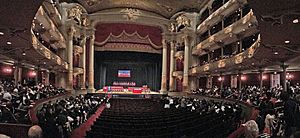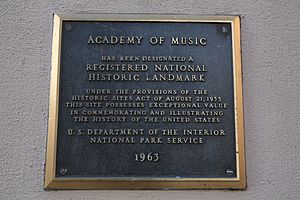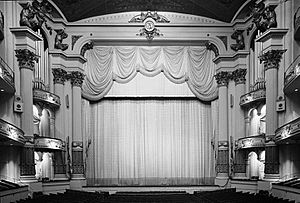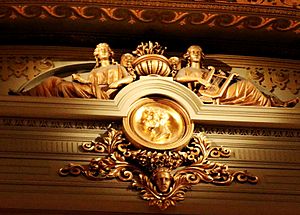Academy of Music (Philadelphia) facts for kids
|
The Grand Old Lady of Locust Street
|
|

The Academy of Music in Center City Philadelphia
|
|
| Address | 240 S. Broad Street Philadelphia, Pennsylvania United States |
|---|---|
| Public transit | 12th–13th & Locust 15th–16th & Locust: PATCO Speedline
|
| Owner | Philadelphia Orchestra and Ensemble Arts |
| Operator | Philadelphia Orchestra and Ensemble Arts |
| Type | Opera house |
| Capacity | 2,509 |
| Construction | |
| Built | 1855–57 |
| Opened | 1857 |
| Website | |
| https://www.ensembleartsphilly.org | |
|
Academy of Music
|
|
| Built | 1855–57 |
| Architect | Napoleon LeBrun & Gustavus Runge |
| Architectural style | Rundbogenstil and Baroque Revival |
| NRHP reference No. | 66000674 |
| Significant dates | |
| Added to NRHP | October 15, 1966 |
| Designated NHL | December 29, 1962 |
The Academy of Music is a very old and famous building in Philadelphia, Pennsylvania. It is a special place where people go to watch opera shows and concerts. Even though it's called an "Academy of Music," it has never been a school! It is located right in the middle of Philadelphia, on a street called Broad Street.
This amazing building was built between 1855 and 1857. It is the oldest opera house in the United States that is still used for its original purpose. People often call it the "Grand Old Lady of Locust Street." Today, it is home to the Philadelphia Ballet and Opera Philadelphia. The Philadelphia Orchestra used to perform here from 1900 until 2001. They still own the Academy, working with Ensemble Arts.
In 1962, the Academy was named a National Historic Landmark. This means it is a very important historical place.
Contents
History of the Academy
Early Years: The 1800s
The Academy of Music first opened its doors with a big party on January 26, 1857. The New York Times newspaper said the theater was "magnificently gorgeous." A month later, on February 25, 1857, the first opera was performed. It was Il trovatore by Verdi, put on by the Max Maretzek Italian Opera Company.
Since 1857, the Academy has been used continuously. Many world-famous performers, conductors, and composers have appeared here. Many important operas and classical music pieces had their first American performances at the Academy. For example, Faust and The Flying Dutchman were first shown in America here. In 1916, the Philadelphia Orchestra performed Mahler's Eighth Symphony for the first time in America.
Besides arts events, the Academy also hosted important public meetings. One notable event was the 1872 Republican National Convention, a big political meeting. In 1889, a unique indoor football game was played here. It was between the University of Pennsylvania and a team from Princeton University. In 1895, during the Philadelphia Phillies baseball season, the Academy even showed live updates of their away games on an electric scoreboard!
The 1900s and Beyond
Many legendary artists performed at the Academy of Music in the 20th century. These include singers like Marian Anderson, Maria Callas, Enrico Caruso, and Luciano Pavarotti. Famous musicians like Vladimir Horowitz, Sergei Rachmaninoff, and Itzhak Perlman also played here. Even composers like Gustav Mahler and Igor Stravinsky visited.
Parts of the 1993 movie The Age of Innocence were filmed inside the Academy. Various music competitions, including the Pavarotti competition, have also been held there.
In the 21st century, after the Philadelphia Orchestra moved, the Academy started hosting many different types of shows. Today, it is managed by The Philadelphia Orchestra and Ensemble Arts. It is used for Broadway shows, comedy, dance, family events, jazz concerts, and much more. It is also a popular place for weddings and other special events.
Building Design
A design competition for the Academy was held in 1854. The Philadelphia company of Napoleon LeBrun and Gustavus Runge won. They used a style called Rundbogenstil, which means "round arch style," for the outside of the building. This style came from Runge's home country, Germany. The building officially opened with a grand ball on January 26, 1857.
The architects wanted to spend most of the money on the inside of the building. So, the outside was made of simple brick and brownstone. They hoped to add marble later if they had enough money, but they never did. The beautiful main hall has an "open horseshoe" shape. This design helps people in the side balconies see the stage better. The hall is surrounded by a thick brick wall to prevent echoes and absorb sound.
The upper balconies are set back and supported by 14 fancy columns. The front of the first balcony is very decorated. The hall can seat 2,389 people. It can hold up to 2,509 if seats are added in the orchestra pit. In 1860, it was noted that nearly 3,000 people could leave the building in just four minutes! This was thanks to the wide hallways and stairways.
Inside the Academy
The inside of the Academy is a great example of American Baroque Revival architecture. The main hall has a huge crystal chandelier. It is 16 feet wide and weighs 5,000 pounds! When it was first put in, it had 240 gas lights. These were changed to electricity in 1900. In 1957, a special electric winch was added to lower it. Before that, it took 12 people four hours to lower it by hand! The chandelier was fixed up in 2008, and missing crystals were replaced.
Above the stage, there is a carving of Mozart. On either side are statues of Poetry and Music. The detailed carvings and gold decorations were made by Charles Bushor and Joseph A. Bailly. The ceiling paintings of figures were done by Karl Hermann Schmolze.
The original seats were very comfortable, with springs and red velvet fabric. Later, more typical theater seats were put in. In 2018, new, more spacious seating began to be installed. In 2007, a large donation of $5.3 million helped restore the Academy's ballroom. This was part of almost $12 million raised for the Academy's 150th anniversary.
Sound and Acoustics
For many years, people in Philadelphia thought the Academy had amazing sound. They believed this was because of a round brick room under the floor. The architects hoped sound would go through the floor, bounce around in this room, and then come back into the hall. However, this idea did not work very well.
Some people have found the Academy's sound to be a bit tricky for orchestras. The sound can seem "dry" and does not echo much. This is because the nearly 2,900 audience members soak up the sound. The Academy was built as an opera house, which usually has less echo than a concert hall.
The "Philadelphia Sound" of the Philadelphia Orchestra was partly due to conductors like Leopold Stokowski and Eugene Ormandy. They worked hard to make the orchestra sound great in the hall. After some changes in the 1950s, Ormandy stopped recording with the orchestra at the Academy.
Even famous conductors had different opinions:
- Fritz Reiner said: "The Academy has very good acoustics although somewhat dry. It is like an Italian opera house."
- Pierre Monteux felt: "This hall is too dry; the tone stops instantly. The sound should have a more flattering carry-over."
Since 1994, big renovations have helped improve the sound. Even though the Philadelphia Orchestra no longer plays there regularly, the Academy still hosts opera, ballet, and other classical concerts that rely on its natural sound. It also hosts Broadway shows, jazz, comedy, and family-friendly programs.
See also
 In Spanish: Academia de Música (Filadelfia) para niños
In Spanish: Academia de Música (Filadelfia) para niños






